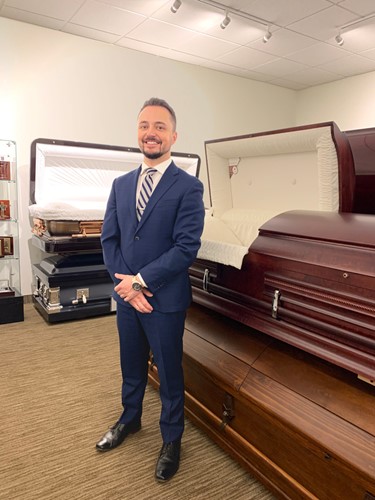
Five Facts to Know about the Occupation of a Thanatologist
Published on May 24, 2022
- Funeral complex
The occupation of thanatologist is really unknown to the majority of the population. We sometimes call them embalmers or undertakers—popular names given to funeral workers many years ago. Although the spelling of the occupation has changed over time, the basics and fundamentals are the same as they were back then. Discover the five things to know about the occupation of thanatologist and learn more about this unusual career.
What is the occupation of a thanatologist?
The thanatologist—driven by a true vocation—is a resource person and plays a major role in supporting families bereaved by the loss of a loved one. He or she organizes funeral rites and can perform thanatopraxy (embalming), while accompanying and guiding loved ones through the administrative process.
Thanatologists must show respect, listening skills and empathy in order to be able to offer professional funeral services and meet the needs of their clients. These qualities are as essential as the technical skills required. They must have excellent communication and interpersonal skills as well as be precise, meticulous and have good dexterity.
 |
''When you're set on becoming a thanatologist, you only realize the extent of the profession when you are facing your first case which, as I imagine, probably goes for any other career choices you may choose. Although, it is a challenging job that requires a great capacity to adjust, it brings me great pride on a daily basis.'' - Jérôme Beaulieu |
|---|
Here are 5 interesting things to know about the occupation of a thanatologist:
1. Thanatologists play an advisory role.
The image of the old man working alone in a funeral home basement is a thing of the past. Thanatologists are primarily advisors, which means that they handle a lot of customer service. Listening, empathy and moral support are therefore very important. Their duties require them to offer guidance and advice on services, fees, means of disposal and administrative procedures, while respecting the funeral rites associated with the various communities.
2. There is a difference between thanatologist (funeral director) and thanatopractor (embalmer).
The thanatologist manages the funeral home, while the thanatopractor is the person who looks after conservation. The thanatopractor takes care of embalming, make-up, dressing and casketing in order to allow the family to keep a final beautiful image of the loved one.
The thanatologist can also be a thanatologist-entrepreneur and own his own funeral parlour. In short, although the two positions share many responsibilities and are often interconnected, they have very different functions.
3. The preparation of the deceased takes an average of 2.5 hours.
The objective of the thanatopractor is to give a more familiar appearance to the deceased, a process that takes an average of 2.5 hours. Thanatopraxy involves several stages of preservation and presentation that require knowledge of biology, chemistry, physics and restorative arts. At times, thanatopraxy treatment times are extended, depending on the complexity of the case.
4. It isn't easy to deal with death every day.
When people choose to become thanatologists, they must be aware that it isn't easy to deal with death on a daily basis. Despite the challenges that this can bring, they must carry out the instructions given by the bereaved families. They must learn to build a shell around themselves, because even with many years of experience, it is impossible to completely detach themselves from the tragedies they witness.
5. The next generation
In Quebec, there are very few establishments that offer training to become thanatologists or thanatopractors. Collège Rosemont in Montreal offers a 3-year training program (technical for the public), which is also offered at Campus Notre-Dame-de-Foy in Saint-Augustin-de-Desmaures (technical for the private sector). Thanatology students must complete internships in the workplace as well At the end of their training, they must obtain a permit to work as a thanatologist.
Moreover, the placement rate for graduates is excellent (between 90% and 100%), and the future of this profession is promising. Since the population in Quebec is aging, it is likely that the demand for thanatologists will increase in the coming years.
If you are interested in the practice of thanatology or if you wish to have more information on this occupation in the funeral field, don't hesitate to contact us. We will be pleased to inform you or guide you in your endeavours. Newcomers are always welcome at the Aeterna Complex.